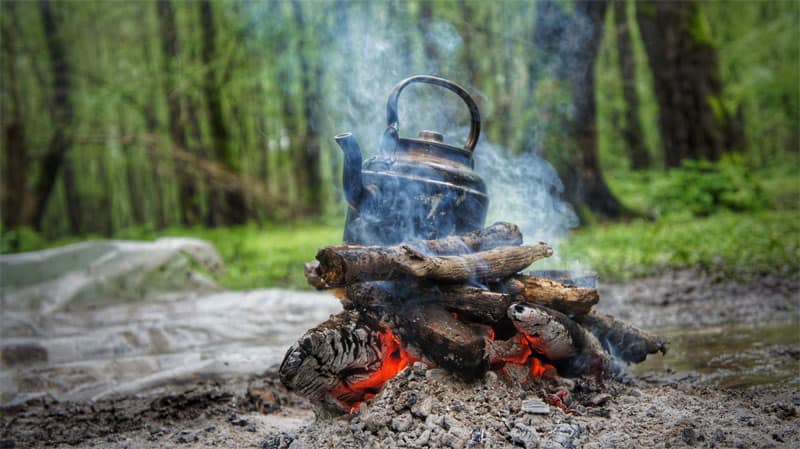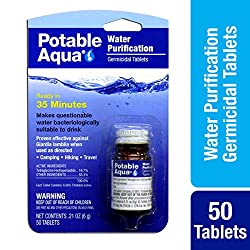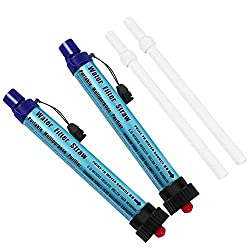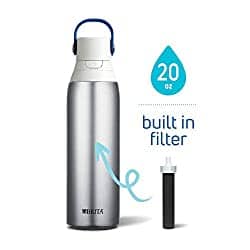There are many ways to purify water. Each water purification method can supplement your emergency water supply. Each of these 18 ways to purify water has pros and cons.
- Boil Water
- Activated Carbon Filter Element
- Purification Tablets
- Distillation
- Evaporation Traps
- Plants
- Straw Style Water Filters
- Solar Water Disinfection
- Chlorine Dioxide
- Water Bottle Survival Kit
- Purification Pumps
- Natural Chemicals
- Carbon Filter
- Ceramic Filters
- Iodine
- Stones
- Sedimentation
- Filter by T-Shirt
In some countries, water is also known as ‘life.’ It is very appropriate, considering the fact that humans can survive weeks without any sort of food but a mere 3 to 5 days without water.
More often than not, you may not find freshwater surface sources before you finish your hiking or camping. In these camping or survival situations you need an emergency water supply or a water treatment method to filter and purify water.
Boil Water

First up, boiling! Boiling is the first and foremost method on this list because it is the easiest way of getting safe water. You have done it at home and have continued to do this for most of your lives, so it is safe to say you know how to do it like the back of your hand.
It is the easiest as well as the fastest way since it only takes about 10 minutes of a rolling boil to approach the ‘safe’ stage. If you’re in the wild, chances are you will have wood to burn at your disposal. Start a fire with the woods and take a pot to put the water in.
When there is enough heat, begin the boiling process. Be careful as water boils as 212F. Let the water boil, and soon you’ll see bubbles forming atop its surface. Continue to keep the water at a rolling boil for another 5 more minutes. Don’t drink just yet! Let it cool down for 10 minutes.
Fun Fact: Always look for water that isn’t clean but is clear. I know it sounds weird, but trust me. This is due to the fact that when you boil water you will surely rid the water of microorganisms but won’t always kill dirt. Hence, other methods can be applied to disinfect water.
If the only water you find in the wild is very dirty and contains mud, then boiling it will not give you water. You will have to use the filtration process to ensure the water is free of dirt. That is why the filtration method is also quite important when it comes to getting water in the wild.
One of the easiest filtration process using natural materials is sand filtration. I know what you’re thinking; get rid of mud by using sand?Hear me out and practice this at home first, and you’ll soon see how well this filtration method works! This is also how to disinfect water with natural materials.
First, take a used bottle and cut it so that it becomes a cone shape. You will require some filter material that has to be placed at the bottom of the cone, mainly the neck of the bottle. It’ll be great if you can get your hands on pebbles or cotton. These items need to cover 3 inches of the bottle.
Then, fill the entire bottle with sand. Pour the water you’ve acquired through this filter into a clean container and you’ll see clearer water coming out of the other end, if not, repeat the process again. You will find that this method is not only effective but cost effective as well, since it requires so little materials.
Activated Carbon Filter Elements
Purification Tablets
A lot of preparation goes into packing the right items when you go camping or hiking in the wild. So, you can also add water purification tablets or drops in your backpack. This iodine infused water will be safe to drink. When you can not find woods or sand available near you and disinfecting water is absolutely necessary, you can use these two things to purify water.
This is how to purify water in the wild without fire. If done in the correct procedure, you will get purified water in no time. Commonly used filtration tablet ingredients include iodine, chlorine, and potassium permanganate.
These items are slowly becoming more popular due to their ability to provide safe water easily. Given that the right amount is administered, these ingredients are quite effective in getting rid of dirt and microorganisms that are a danger to your health.
Use the above filtration process just to ensure clean water and take required amount of water (preferably 20liters). Then pour the tablet or drop as instructed on its back. Make sure the water and the ingredient mixes well and mix them for 20 seconds at least. Be sure to wait 20 minutes before you consume the water.
Distillation
If you are in a tropical region or Pacific region, this method will come in particularly handy. Unfortunately, fresh water found in the tropical regions often contain sodium and minerals in harmful amounts. Hence, if you aren’t careful and drink it without precaution, you may dehydrate yourself further.
Distillation is an efficient method of procuring safe water by getting rid of these salts and minerals. Notwithstanding, this method requires a few items, which have to be packed when you pack for your trip. The items include; two containers (one larger than the other), and a cover.
You will need to apply the condensation process for this method to work. Place the container smaller of the two on top of the bigger one. Place salt on the bigger container before you place the smaller container with the water on top of it. Cover these two containers and condensation will separate the dirt and water.
Make sure the cover is more upon the smaller container. That way, the condensation will accumulate on the cover, returning to the smaller container. Although this method doesn’t purify the water completely, it does distill it, which you can then purify fully using a better purification method.
Evaporation Traps
In some wilderness, you will not find a source for water as easily as you’d hope. Therefore, you can apply the evaporation trap method to get water without a water source. It is a creative solution to a dire problem in case you’re badly in need of water and cannot spot a water source.
Look out at the region you’re in and try to locate a place that may look like it was a riverbed. When you are able to find such an area, dig a 19 inches hole in it. It is necessary that you find a riverbed because that will ensure you will get a lot of water. Remember, the more holes you dig, the more water you’ll get.
However, if you are unsuccessful in locating a riverbed, you will have to dig deeper holes till you reach the wet land. Next, use the non-poisonous plants around you and place them in the holes. Take cups to put them in the middle of the holes. You’ll need to cover these holes with plastic covers.
Use sand to seal the plastic cover on top of the holes. You’ll also need to place a rock on the plastic cover so that it does not touch the water container. Now all you got to do is wait for the sun to evaporate the water after which you can collect it from the cups.
Specialized Plants
There are various plants in the wild that have the properties to disinfect water. However, you need to be an expert on these plants and have enough knowledge about them before you use the wrong plant and harm your health. Even the smallest errors of using the wrong plants may result in dangerous problems.
For this method, you’ll need to have a string, plastic bag and of course, a plant. The ideal plants for this method are the ones which have had a good exposure to the sun because that improves the purification process.
It’s better to select branches of plants containing healthy leaves, and clean them as best as you can. Cover the leaves with plastic wraps and seal them with the strings. Wait a few days for the water to collect in the bag.
Straw Style Water Filter – Survival Straws
Some of you are up for undertaking whatever needs to be done in the wild for a safe and adventurous experience. But, for those of you who are reluctant to go through too much trouble, survival straws are a reliable option for safe water.
Fortunately, as the number of people interested to experience life in the wilderness is growing, so is the number of equipment being designed to make that adventure easier. They are available in most shops selling hiking or camping gear or equipment.
Once you get your hands on a survival straw, put it above a water body. Place it on the water for about a minute so that the water can move up to the filter membrane. Then, suck on the straw like you would from a cup of juice. You can drink this water tension-free because this water is safe and filtered.
You can see that the survival straw is a hassle free process of acquiring safe water since all you have to do is basically nothing!
Solar Water Disinfection
In recent times, solar powers have become a vessel for various things, so why not for disinfecting water as well! It is not surprising that solar power disinfection is a popular method amongst outdoor enthusiasts. You just need to be in a sunny environment and this method will work wonders.
The UV rays will kill the harmful contaminants in the water. You need to have a clear plastic bottle for this method since the UV rays have to be able to penetrate the surface without any interruption. Its only disadvantage is that it won’t be successful in other weather conditions; so you may only use it when it’s sunny.
Take the clear plastic bottle and fill it up with water to its very edge with the water you find. Then, position it directly under the sunlight so that the UV rays may do their work. Make sure there is no shade anywhere near the bottle.
Also, you need to start this method a few days before your stored water runs off because you will need to keep the bottle under the UV rays for a couple of days. After a few days, you may drink the water.
Chlorine Dioxide
Not many people carry items such as chlorine when they’re about to go hiking. However, chlorine can serve as a very effective substance for cleaning your water when you really need it.
There are quite a few things you need to keep in mind if you use this method. For example, the amount of chlorine you use depends on the quality and temperature of that water. For water that is greyish, it is advisable to use 4 drops of chlorine and 2 drops for water that is slightly clear.
After putting the drops in, shake the container well to mix the chlorine with the water evenly. Open 2 inches of the cover and turn the bottle upside down to take some water out which will get rid of lead and the threads from the bottle.
Again cover the bottle and be sure to see that the chlorine is covering all the surface of the bottle. Place the bottle in a shaded area and keep it there for thirty minutes. Then you may drink the water safely.
Water Bottle Survival Kit
For beginners about to experience the wild for the first time, it is suggested that a water bottle filter should be packed. Fortunately, you will find this instrument easily available in the shops. These bottles have been designed with the water filter built in them.
It is easy as well as hassle free so you do not need to worry about much when you use this method.
Take the bottle and open it. Next, add the water you want to purify through its opening. Squeeze the filled bottle so that the filter can clean the water for you. This has to be done for 15 minutes after which you can drink the water.
Purification Pumps
There are various filters and water purifiers available in the market that are portable and easily accessible. These pumps take in the unclean water and produce drinking water.
This is done via ceramic or charcoal filter and other chemical treatments in-built into the pump. You pour the water through the pump and the pump itself cleans the water and drops it into the bottle.
If you spend a bit more, you can get water bottles that have the pump inside them. Hence, you will not have to pump into one and then pour the water in another water bottle. The process will be much simpler!
Natural Chemicals
As I’ve discussed before, you will find many ingredients in the wild that will make disinfecting water very easy. Plants with antimicrobial properties are the ones you should be on the lookout for.
Oregon Grape is a well-known purifier for plants. When you find it, chew on the root of the plant; once before and then after drinking the water you’ve found. The berberine in the plant is effective in protecting you from harmful contaminants in the water because it has antimicrobial alkaloid that kills germs.
After you eat the roots of the plant, the antimicrobial properties kick-in and kill the germs in the water.
Carbon Filter
For generations, carbon has been used as an efficient method of purifying water. Carbon is popular for getting rid of impurities and harmful chlorine from the water. Since it has been around for a while, methods have been developed to make it even more efficient.
The water purifiers in your home may also contain activated carbon. In these water filters too, there are activated carbon. But these portable carbon filters have carbon in granular and solid shape.
Get yourself a filter that has activated carbon inside of it. Pour the water through the filter and carry it around with you while you explore the wild, and it’ll soon be ready for drinking.
Ceramic Filters
Similar to carbon filters, ceramic filters are also quite effective in removing impurities from water. Carry a ceramic material with you when you’re packing your things for the adventure.
Pour water through holes in that ceramic item. For many years, this method has gained popularity due to its effectiveness. When you pour water through the ceramic holes, drinkable water will come out of the other side.
However, if you’re in a region where you know the water may contain pesticides and organic pollutants, then this method will not work because ceramic cannot kill pesticides or organic pollutants. In those cases, use a carbon filter first.
Iodine
If you do not have iodine at home, you can access it at normal shops. Microorganisms and other harmful things do not stand a chance against iodine. When you find water in the wild, pour it in a container.
Depending on the cleanliness of the water, add five or ten drops in the water, (five if the water is clean and ten if the water is dirty). You have to shake the container so that the iodine can clean the dirt from the water.
Find a shaded place and leave the container there for about an hour. You must make sure to place it in a dark place since iodine is sensitive to light. After an hour is complete, you can drink the water.
Stones
For this one, you need to travel back to the Stone Ages, when they used stones for everything. Sometimes, you will not have enough supplies in the wild to get safe drinking water.
If you forgot to take a pot with you, try to find a stone that has at least a small space in it. Pour water into that hole and put the stone pot over a fire.
In another method, if you do have a pot, pour the water into it and place clean and cold stones in the water. This method will then purify the water for drinking.
Sedimentation
If the only water you can find is filled with dirty particles, don’t be disheartened. You can use the sedimentation method, which will separate the particles from the water and give you clean water, except the bottom side of the container.
Take the water and put it into the container. Let the water sit in the container for a minimum of two days. At the completion of two days, pour the water in another container, taking care not to pour the dirt from the other container as well.
Take the water from the second container and pour it into a sand filter again. This other method has to be used in order to be absolutely sure that the water is safe for drinking.
T-Shirt
Sometimes, you may find yourself in a situation where you do not have enough supplies to get purified water, don’t panic yet because all hope is not lost. People have been going in to explore the wild for many years and so a variety of methods has been discovered to disenfect water.
This one will require your T-shirts and rods sticks. These two items will give you two layers of filtered water.
Create a triangle shape by inserting the three sticks into the ground. Then, tie the t-shirts one on top of the other. Place a container below this filter, which will collect the water. Pour the water over this filter. If you see the water is not clean enough, repeat the process a few times.
Conclusion
Survival in the wild has become easier due to the discovery of new ways to purify water since it is a very important ingredient to keep us alive. Use these methods if you’re ever in the need of safe drinking water.
Knowing these water disinfecting tools in a camping or emergency situation that show you how to collect water and ensure that it is not dangerous water could be the difference between life and ….



